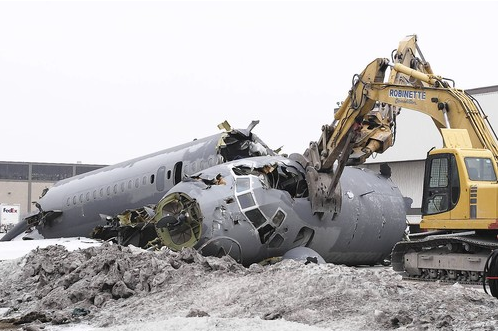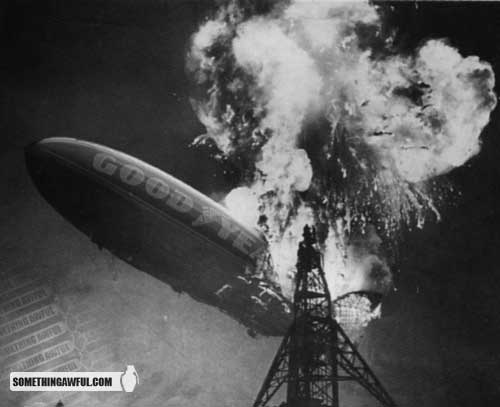I suppose I’m getting sentimental in my old age, but this photo brings me to the first pangs of sadness, even grief.
A forty-year-old DC-9 is being dismantled after being damaged by a ground vehicle at Midway Airport in Chicago. After being stripped of its avionics and other high-end materials, it’s being broken apart for scrap. Something about the scene really gets to me, as if it were a beloved old dog being laid to rest. But this is the fuselage of a plane, one I probably never even flew in, and what if I had? This is like getting sentimental over a bus stop bench that you drove by once or twice. Who cares?
Perhaps it’s because the the wings are gone and the plane is broken in two and laying at an angle on the ground; that, along with the appearance of a face and mouth makes it seem like an animal, something that once was alive and now is returning to the earth. This organic feeling is heightened by contrast with the machine that is tearing into it–and looking like some large insect predator feeding on a carcass. I would no more identify with a garden slug or snake or any rotting backyard mammal than with a machine, but the innate fear of being prey may have changed all that. A broken machine has become the embodiment of mortality, and with that the horror of being killed and eaten, or, almost as bad, dying alone and unmourned.
This is not the usual reaction to seeing machines hit the scrap heap. Usually there is some fascination with the heaps of twisted metal and similarly mangled objects following any accident, but no grief. “Was anybody hurt?” we ask, not referring to the vehicles. Sometimes we go further, taking out our rage against the machine in delightful visions of cars exploding or other familiar objects getting what they deserve. Like this:
I once read about a place in New York City where you could take your small appliances, put them at the business end of an indoor firing range, and blast away. I’d absolutely love to go there. But that’s personal. There is something collective, and importantly so, in the reaction I had to the DC-9. Something like what was captured in this painting about the Hindenburg explosion.
John and I included this in No Caption Needed (the book), and I’ll repeat a bit of what we said there: “By drawing on the traditional form [of the pieta] and making the machine so palpably organic, the work fuses two contradictory tendencies: she mourns the burning body and so the humanity burning in a fire of their own making, and she mourns the machine itself, a beautiful, almost living thing, a life form of the machine age that, like the age itself, is doomed to catastrophe.” Maybe the photo from Midway touched the same nerve. If we don’t mourn the death of a machine, we are in some degree indifferent to our own demise.
Photographs from the Chicago Tribune, SomethingAwful.com, and Bruce Duncan.



Anyone who loves ships and the sea knows all too well what you are talking about. Aside from living creatures there is no “death” sadder than a ship going to the breaker’s yard. Any sailor would rather a ship sank than be broken up.
Check this guy out, then – http://www.hebig.org/photos/
The site’s called ‘Endangered Machinery’. I think he’d sympathize with you.
The animal metaphor is strong in this image. The DC-9 lays there like a wounded, friendly, harbor seal. A old companion of the wharf being devoured in her old age by a younger more aggressive machine. Her back is broken after years of devoted service.
She brings to mind an era of flight when it was a luxury, or at least an adventure. Before coast to coast commuting made airports and airplanes into dim transit zones for weary businessfolk. I was young when the DC-9 was state of the art. I flew the DC-9 before I was aware of the seemingly irresolvable complexities of politics and the dire state of the environment, a condition this DC-9 and all other planes no doubt has contributed to. A symbol of youth and innocence is getting chewed up in the maw of progress.
But, much of that is sentiment. The world was no better then than it is now. Whatever fruit we are harvesting today was well on the tree when this plane was in its prime. But the great thing about looking back to youth is that we know that we weathered the anxieties of the day. Today the fears of 40 years ago seem resolved, or at least more youthful, while the pressures of age and awareness press in on us. Should we have the luxury of such time, perhaps we will look back the same way on a Boeing 787 Dreamliner as it heads a machine boneyard of the future. Then, even wiser, we will remember the anxieties of today and know that we weathered the past.
Or not. Will we make it that far? That is always the question of the day.
[…] mourns “Endangered Machinery” is here, which I learned about after an earlier post on When Machines Die. | | | | | | […]